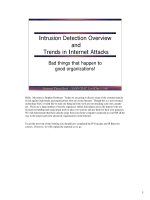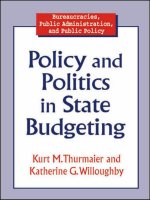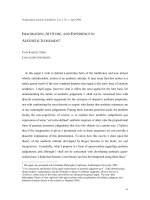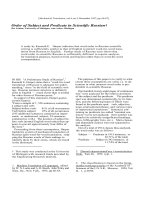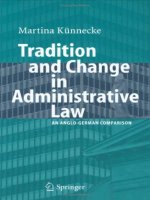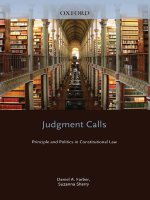Judgment Calls: Principle and Politics in Constitutional Law pptx
Bạn đang xem bản rút gọn của tài liệu. Xem và tải ngay bản đầy đủ của tài liệu tại đây (1.8 MB, 218 trang )
Judgment Calls
This page intentionally left blank
Judgment Calls
Principle and Politics
in Constitutional Law
daniel a. farber
and suzanna sherry
1
2009
1
Oxford University Press, Inc., publishes works that further
Oxford University’s objective of excellence
in research, scholarship, and education.
Oxford New York
Auckland Cape Town Dar es Salaam Hong Kong Karachi
Kuala Lumpur Madrid Melbourne Mexico City Nairobi
New Delhi Shanghai Taipei Toronto
With offi ces in
Argentina Austria Brazil Chile Czech Republic France Greece
Guatemala Hungary Italy Japan Poland Portugal Singapore
South Korea Switzerland Thailand Turkey Ukraine Vietnam
Copyright © 2009 Daniel A. Farber and Suzanna Sherry
Published by Oxford University Press, Inc.
198 Madison Avenue, New York, New York 10016
www.oup.com
Oxford is a registered trademark of Oxford University Press.
All rights reserved. No part of this publication may be reproduced,
stored in a retrieval system, or transmitted, in any form or by any means,
electronic, mechanical, photocopying, recording, or otherwise,
without the prior permission of Oxford University Press.
Library of Congress Cataloging-in-Publication Data
Farber, Daniel A., 1950–
Judgment calls : principle and politics in constitutional law /
Daniel A. Farber and Suzanna Sherry.
p. cm.
Includes bibliographical references and index.
ISBN 978-0-19-537120-8
1. Judicial discretion—United States. 2. Judicial process—United States.
3. Law—United States—Interpretation and construction.
I. Sherry, Suzanna. II. Title.
KF8840.F37 2008
347.73'12—dc22 2008012374
987654321
Printed in the United States of America
on acid-free paper
This one is for Nora For Paul, again and always
—d.a.f —s.s.
This page intentionally left blank
Life is painting a picture, not doing a sum.
—Oliver Wendell Holmes
This page intentionally left blank
Preface
This is a short book, but it took a long time to write. In two previous books, Beyond
All Reason and Desperately Seeking Certainty, we criticized some currently popular
theories like originalism, the view (held by many conservative constitutional
scholars) that the Constitution’s meaning is fi xed by the history of its creation.
We also criticized theories of leading scholars at the other end of the ideological
spectrum. Having taken shots at the views of so many of our academic colleagues,
it seemed only fair that we lay out our own views of how law, and constitutional
law in particular, should operate. Easier said than done! It took us longer than we
would like to admit to crystallize our own views, let alone write them up in a com-
prehensible fashion.
Our thesis begins with the assumption that many key constitutional cases leave
judges with leeway because the results are not clearly dictated by any source of con-
stitutional authority, whether the language of the Constitution, its history, or prec-
edent. We believe, however, that this leeway does not preclude reasoned decision
making. Our major aim is to explain and defend the thesis that even in hard cases,
reasoned legal decisions are possible. We also want to show how judges can make
such decisions, what kinds of judges are likely to be best at doing so, and which
institutional structures are most conducive to reasoned decision making.
One goal of this book is to defend the role of the judiciary, particularly the
Supreme Court’s role in shaping constitutional law. American constitutional law
has developed as a series of Supreme Court decisions erected on a foundation of
constitutional text and history. Critics sometimes argue that as currently practiced,
constitutional law is just a charade whereby judges conceal their political views
and pretend that decisions are based on something beyond personal preferences.
Although these critics agree on the diagnosis, they disagree about the cure. Some
want judges to play a smaller role, leaving constitutional decisions to the political
process; others want judges to follow some methodology that will supposedly lead
to objective, nonpolitical results. As to the latter, it is well to recall the words of
Justice Cardozo, one of the giants of twentieth century jurisprudence: “[W]e all
need to utter [a prayer] at times when the demon of formalism tempts the intellect
with the lure of the scientifi c order.”
1
If judges must attain perfection in order to be legitimate, the critics are clearly
correct in their disdain for our current body of constitutional law. But this demand
for perfection is a guarantee of failure. We view the judiciary as a human institu-
tion, and so we ask only whether the judiciary can do its job well enough to make
the enterprise worthwhile. We believe the answer is clearly yes: Judges collectively
can do a reasonably good job of deciding constitutional issues, guided by text,
precedent, history, and contemporary values. As a great Chief Justice of the Israeli
Supreme Court put it, “[t]he life of the law is complex. It is not mere logic. It is not
mere experience. It is both logic and experience together.”
2
The materials with which judges work do leave room for leeway, but
we think judges can operate within this leeway in a responsible, reasoned way. We
think judges do fairly well on the whole; they might do a little better with some
changes in legal culture and institutional processes. In short, we think judges can
be both guided by “the law” and also active participants in molding the law.
The biggest barrier to accepting this view is the common assumption that
law equates with logic and is therefore the opposite of discretion. We believe,
however, that the reasoned exercise of discretion is not an oxymoron. In this,
we follow in the footsteps of the old “legal process” theorists of the 1950s, but
we reject their assumption that reason will necessarily produce “right answers”
if judges are suffi ciently smart and suffi ciently principled. Decisions inevitably
involve judgment calls, and reasonable people will sometimes disagree about the
best answers.
x Preface
We should make a brief comment on references. We provide sources for
direct quotations and other key materials in the notes. All of the sources for each
paragraph are combined in a single note. For readers who are interested in explor-
ing topics in more depth, we also have a lengthy discussion of the literature at the
end of the book.
For readers who have not followed the debates on constitutional theory, it
may be helpful to explain some basic terminology at the outset. Here are some key
terms:
• Originalism is the view that, at least where an issue is not irrevocably
settled by precedent, cases should be decided on the basis of the original
meaning at the time a constitutional provision was adopted. Sometimes
this approach is phrased in terms of the original intent of the framers or
the original understanding of those who ratifi ed a constitutional provi-
sion. More recently, originalists have tended to refer to the original “mean-
ing” of the constitutional provision. The key element is that constitutional
meaning is fi xed, at least where it can be ascertained, in the late eigh-
teenth century when the original Constitution and the Bill of Rights were
adopted, or in the mid-nineteenth century when the Fourteenth Amend-
ment was adopted. Those holding the opposing view are more apt to refer
to the “living Constitution.”
• Textualism is closely related to originalism, especially in its “original
meaning” form, but emphasizes the importance of the specifi c words used in
the Constitution.
• Foundationalism is the view that constitutional law should rest on a
single value (such as majoritarianism or protection of individual rights) or
a single interpretive strategy (such as originalism or textualism) rather than
involving a pluralist constellation of values and methods of interpretation.
• Pragmatism is a word that seems to mean many things to many peo-
ple. In the constitutional setting, we view it as entailing the pursuit of mul-
tiple goals (such as legal stability, majoritarianism, and protection of minority
rights). More generally, it is the view that judicial decisions, at least in hard
cases, inevitably require a consideration of values and not merely an “objective”
application of authoritative texts (whether constitutional, statutory, or judi-
cial). Constitutional provisions and precedents thus are incapable of generating
answers to hard cases on their own—which does not mean they are irrelevant.
• The countermajoritarian diffi culty refers to the supposedly anti-
democratic nature of judicial review, since it allows courts to overturn the
Preface xi
handiwork of elected offi cials. Much of constitutional theory seems to view
this as the central problem of constitutional law, although we will argue
otherwise.
As with all our books, we could not have done it alone. We thank Stephen
Jordan, Andy Lewis, and Hannah Edelman for providing a variety of research assis-
tance, and Dianne Farber and Paul Edelman for carefully reviewing the fi nal text.
Janelle Steele took a pile of individual chapters—in two different word processing
formats—and turned them into a manuscript suitable for further mix-and-match
editing. Over the years during which we worked on this book, four different deans
have offered us support, fi nancial and otherwise: Bob Berring, Christopher Edley,
Edward Rubin, and Kent Syverud. Finally, we thank the friends and colleagues
who have helped us develop and hone our approach to constitutional adjudication.
Because this book is an outgrowth of such a long gestation, it is diffi cult to list all
of the individuals who contributed to our thinking. We are, however, deeply grate-
ful to all of those with whom we have discussed these issues, including friends who
vehemently disagree with us.
Dan Farber
Berkeley, California
Suzanna Sherry
Nashville, Tennessee
xii Preface
Contents
1 Introduction, 3
I The “Problem” of Judicial Review
2 The Inevitability of American Judicial Review, 11
The origins of judicial review, 12
The unsatisfactory alternatives to judicial review, 13
The Supreme Court and the states, 16
3 The Democracy Worry, 21
Worries about judicial review, 22
The countermajoritarian diffi culty, 23
Misguided efforts to escape the countermajoritarian diffi culty, 26
II Discretion and Judgment
4 How to Think About Discretion, 35
Decision making without recipes, 36
Discretion, legislative and otherwise, 38
The administrative analogy, 40
5 Reason and Relevance, 43
The importance of reasoned elaboration, 44
What arguments are relevant? 46
How judges should make value judgments, 48
The risk of overreaching, 50
6 The Anatomy of Judgment, 53
Judicial reasoning and the common law, 54
Improving judicial decision making, 56
xiv Contents
III Precedent as a Safeguard
7 Respect for Precedent, 63
Precedent and the rule of law, 64
The value of precedent, 70
Precedent and the modern constitutional order, 72
8 Explaining Precedent, 75
What kinds of precedents? 75
What does it mean to follow precedent? 78
Does precedent really matter? 81
IV Process Safeguards
9 Deliberation and Multiple Decision Makers, 87
Tiered, multimember courts, 88
Judicial deliberation, 90
Other structural supports, 93
Public scrutiny of judicial opinions, 94
10 Transparency, 97
Failures in transparency, 99
Arguments against transparency, 102
11 Incrementalism, 105
Incrementalism and school desegregation, 106
Incrementalism and the First Amendment, 108
When process fails, 110
V Internalized Safeguards
12 Professionalism and the Selection Process, 113
Professional norms, 113
Judicial selection and politicization, 116
Some institutional changes, 119
13 The Role of the Legal Academy, 123
Scholarship and popular perception of the courts, 124
The traces of postmodernism, 125
The turn toward novelty, 126
Suggestions for improvement, 129
Contents xv
VI Case Studies
14 Terrorism, 133
15 Abortion, 141
16 Affi rmative Action, 157
Closing Words, 167
Notes, 169
Bibliographic Essay, 181
Index, 197
This page intentionally left blank
Judgment Calls
This page intentionally left blank
3
T
his is a book defending judicial review: the power of courts to strike
down laws that violate the Constitution. Judicial review was an Ameri-
can invention, but it has spread to most democracies around the world. Courts
in countries as diverse as Canada, India, Israel, Germany, and South Africa now
exercise the power to enforce their constitutions.
Ironically, American judicial review has seemingly suffered a kind of crisis
of legitimacy at home just when it has attained acceptance abroad. Some critics
denounce judicial rulings as politics disguised in legal jargon. Other critics seem-
ingly believe that judicial review can be salvaged, but only by adopting some rigid
method for deciding cases, such as strict adherence to the original understanding of
the Constitution at the time of its adoption. Both sets of critics agree that consti-
tutional law, as it has actually been practiced, allows a few justices to impose their
political preferences on the population at large. Their solutions may vary, then, but
their diagnosis of the problem is the same: When it comes to judicial discretion,
it is either the heavens or the abyss. The rhetoric adopted by critics suggests that
1
Introduction
4 Judgment Calls
constitutional decision making comes in only two fl avors: either pure politics or
pure formalism. Unless judges in constitutional cases can be tightly constrained by
“strict constructionist” approaches such as originalism or textualism—and some do
not think this is possible—the only alternative seems to be the unfettered discre-
tion of politicians masquerading as judges. For these scholars, there is no middle
ground.
1
We disagree, and in this book we describe and defend this middle ground.
Constitutional decisions can be judicial and principled (and thus fi rmly rooted in
the rule of law rather than in politics), as well as judicious and pragmatic (and thus
range beyond the narrow confi nes of text and original intent). Good constitutional
adjudication should be neither the mechanical application of formal rules nor the
freewheeling exercise of pure politics.
Lawyers know that some arguments are “rational”—they do not violate any
of the rules of logic—but not reasonable; others fail to qualify as legal arguments
because they involve extraneous considerations. Our thesis is that judicial deci-
sions can be judged on the basis of this standard of reasonableness—whether their
readings of texts are plausible, whether they consider all of the relevant factors
(but not others), whether they acknowledge and adequately account for compet-
ing considerations, whether they articulate plausible distinctions and intelligible
standards—in short, on the basis of the strength of their legal reasoning. This may
seem like an uncontroversial thesis—and it should be—but in fact we have received
remarkably sharp rejoinders from skeptics.
To be clear, we do not mean that legal reasoning is a purely objective exercise
that has no connection to the varying perspectives and values of judges. Judges do
not operate in a vacuum, and their worldviews inevitably—and properly—shape
their rulings in hard cases. But judges operate in a different world than do legis-
lators. There are both internal and external constraints on their decisions. These
constraints do not provide defi nitive answers to every case. Especially in important
cases, reasonable judges may differ about the correct outcome. How judges resolve
these hard cases is inevitably connected with their views of the world and their
political leanings. But there is a space between ironclad logic and unrestrained dis-
cretion, a space in which judges as well as administrative offi cials often operate. Try-
ing to eliminate this middle ground is fruitless. Instead, we need to consider how
judges can responsibly exercise their leeway in deciding hard cases—or in other
words, what makes it possible for the rule of law, rather than lawless fi at, to operate
in a world that lacks the comforting certainty of mathematical reasoning.
This book seeks to present a new picture of judicial review—new in the way
it combines elements, though not in the individual elements. We seek to reconcile
Introduction 5
the democratic rule of law with the recognition that judges have discretion. That
discretion sometimes requires judges to make controversial value judgments. Our
argument is directed in part against those who see a stark choice between a for-
malistic conception of law and raw politics as the basis for judicial decisions. Our
approach to constitutional adjudication, then, cannot be captured in a catchword
or a set of instructions. We must instead describe in detail the processes by which
judges should—and largely do—decide constitutional cases, and the built-in con-
straints that fi lter the effect of politics or personal values.
Implicit in this vision of judicial reasoning is an understanding of the role
of the Supreme Court in American society. We do not see the Court as either the
keeper of ancient wisdom (as some originalists seem to) or a crusader for social
reform (as some progressives would like). Rather, we view the Court’s role as evo-
lutionary, fostering change and also maintaining stability. Sometimes the Court’s
role requires it to frustrate the efforts of elected offi cials or ignore some indications
of public opinion. This is not surprising given that a key role of constitutions is to
protect political minorities. But constitutions are also meant to empower govern-
ments and democratize the political process, and it is not surprising that these too
are functions of the Court.
In order to understand how judges should implement this role, we will address
a broader range of questions than one might expect to fi nd in a book on constitu-
tional adjudication. Indeed, we will not talk much about the text of the Constitu-
tion, because—as we suggest in the next chapter—it usually does not offer much in
the way of either guidance or constraint. Instead, we will focus on both positive and
negative infl uences on judicial decision making. So we include a lengthy discussion
of the role of precedent as well as comments on seemingly unrelated topics such as
legal education, the structure of the American judiciary, and the judicial selection
process. Focusing on how all of these infl uences work together to shape judicial
behavior will give a much more realistic picture of judges and judging. It will help
us evaluate the current state of constitutional adjudication as well as enable us to
suggest improvements.
In the chapters that follow, we try to describe the judicial role from both a
positive and negative perspective, to explain both what judges should aspire to and
what keeps them from straying too far from those aspirations. The former turns out
to be the briefer discussion. Much of our emphasis in this book is on the forces that
help channel judicial decision making and prevent it from degenerating into simple
fi at. This emphasis is a response to current tendencies to view constitutional deci-
sions as an exercise in ideology or to go to the other extreme by trying to shackle
judges to a rigid theoretical framework.
6 Judgment Calls
In emphasizing the restraints on judges, we do not mean to ignore the degree
of creative statesmanship involved in the judicial role. Good judges do not feel
free to make constitutional law into whatever shape they desire, but they do feel
the responsibility to advance the basic goals of our constitutional democracy in a
changing world. They do not think of themselves as legislators or as having a free-
wheeling mandate to improve the world, but they take seriously the impact of their
decisions on society.
Taking judging seriously requires us fi rst to place judicial review in context.
We begin, therefore, by “normalizing” judicial review. In the next two chapters,
we argue that rather than being an antidemocratic aberration, judicial review is an
integral part of our constitutional system.
Having rehabilitated judicial review as an American institution, we turn our
attention to how good judges make decisions. In chapters 4 through 6, we ana-
lyze the concepts of discretion and judgment, showing how to distinguish between
arbitrary decision making and responsible legal judgments. These three chapters—
part II of the book—form the core of what might be called our positive description
of judging. They offer both guidelines for judges who honor the rule of law and
criteria for evaluating judicial decision making.
But readers concerned about judicial discretion will want more reassurance.
We therefore turn in parts III, IV, and V to the pressures that keep judges from
either freely imposing their own values or deciding cases on a purely ad hoc basis.
We describe and defend three key safeguards against judicial lawlessness: (1) adher-
ence to precedent, (2) process constraints, including reasoned deliberation, trans-
parency, and incrementalism, and (3) internalized norms. Although these might
not seem like powerful restraints on judges’ political impulses, we will demonstrate
that they do have real effects. We rely not only on our intuitions as students of the
legal system, but on rigorous empirical studies. And even where these safeguards do
not serve to constrain, they nevertheless provide tools with which to evaluate and
critique less than stellar judicial behavior.
Justice Holmes famously said that the life of the law is experience rather
than logic. With this injunction in mind, we turn away from abstractions in the
fi nal portion of the book to provide some critical examples of how the Court
has sometimes succeeded and sometimes failed in its exercises of judgment. As
case studies, we have picked three of the most important and sensitive issues that
the Court has confronted in the recent past: terrorism, abortion, and affi rmative
action. None of the judicial opinions in these areas comes close to being perfect.
They fail in various ways, and with varying degrees of seriousness, to meet the
ideal of reasoned decision making that we have advocated. Nevertheless, they
Introduction 7
show that judicial decision making is not just a matter of ideology. Precedent,
history, and values do matter, and the result is something that cannot be readily
dismissed as judicial fi at.
Our purpose is not to place judges on pedestals. They are generally respon-
sible, hard-working individuals, but as prone to error as the rest of us. Nor are they
moral prophets or social reformers who can rescue society from its follies. What
judges can do, however, through the evolving fabric of constitutional doctrine, is to
provide a framework for democratic governance—one that respects the authority
of the majority while providing basic protection for minorities. That is not every-
thing, but it is a lot—and it is worth celebrating and protecting.
This page intentionally left blank


